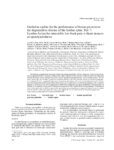1 - 25 of 24
| Creator | Title | Description | Subject | Date | ||
|---|---|---|---|---|---|---|
| 1 |
 |
Couldwell, William T. | Surgical treatment of craniofacial fibrous dysplasia in adults | Craniofacial fibrous dysplasia is a rare disorder that may require neurosurgical expertise for definitive management; however, surgical management of FD in adult patients is uncommon. Although other therapies have been shown to slow progression, the only definitive cure for adult craniofacial FD is ... | 2014-01-01 | |
| 2 |
 |
Couldwell, William T. | Strategies for the management of nonsecreting pituitary adenomas | The two objectives of treating pituitary tumors are: (1) relief of signs and symptoms attributable to mass effect, and (2) correction of hypo - or hypersecretion of adenohypophyseal hormones.7 When nonsecreting tumors are specifically considered, correction of endocrine abnormalities may be of les... | Pituitary adenomas; Transsphenoidal surgery | 1991 |
| 3 |
 |
Couldwell, William T. | Inhibition of growth of established human glioma cell lines by modulators of the protein kinase-C system | The protein kinase-C (PKC) second messenger system contributes to regulation of cell growth and differentiation. This study was undertaken to examine the effects of modulators of the PKC enzyme system on the state of differentiation and proliferation rates of human gliomas in vitro. The administrat... | Protein kinase C; Phorbol ester; Cell proliferation; Tumor cell growth; Astrocyte; Glioma; Immunohistochemistry | 1990 |
| 4 |
 |
Couldwell, William T.; Viskochil, David H.; Fults, Daniel Webster | Molecular, genetic, and cellular pathogenesis of neurofibromas and surgical implications | NEUROFIBROMATOSIS 1 (NF1) IS A common autosomal dominant disease characterized by complex and multicellular neurofibroma tumors. Significant advances have been made in the research of the cellular, genetic, and molecular biology of NF1. The NF1 gene was identified by positional cloning. The function... | Loss of heterozygosity; Malignant peripheral nerve sheath tumor; Plexiform Neurofibroma; Spinal neurofibroma | 2006 |
| 5 |
 |
Couldwell, William T. | Simple closure following transsphenoidal surgery | The most common nonendocrine complication after transsphenoidal surgery is cerebrospinal fluid (CSF) leak. Many neurosurgeons have advocated the routine reconstruction of the floor of the sella turcica using autologous fat, muscle, fascia, and either cartilage or bone after transsphenoidal surgery t... | 2006 | |
| 6 |
 |
Couldwell, William T. | Protein kinase C inhibitors suppress cell growth in established and low-passage glioma cell lines. a comparison between staurosporine and tamoxifen | WE HAVE PREVIOUSLY demonstrated that the proliferation of established human glioma cell lines correlated with protein kinase C (PKC) activity and that a relatively selective PKC inhibitor, staurosporine, inhibits glioma cell proliferation. The purpose of this study was to determine whether low-passa... | Staurosporin; Tamoxifen; Protein kinase C; Glioma; Brain neoplasm; Glioma cell lines | 1993 |
| 7 |
 |
Kestle, John R. W. | Change in ventricular size and effect of ventricular catheter placement in pediatric patients with shunted hydrocephalus | OBJECTIVE: The multicenter, randomized pediatric cerebrospinal fluid shunt valve design trial found no difference in the rate of shunt failure between a standard valve, a siphon-reducing valve (Delta; Medtronic PS Medical, Goleta, CA), and a flow-limiting valve (Orbis Sigma; Cordis, Miami, FL); ho... | Shunt failure; Valve design; Ventricular size; Ventricular catheter placement | 1999 |
| 8 |
 |
Couldwell, William T. | Protein kinase C activity correlates with the growth rate of malignant gliomas: Part II. Effects of glioma mitogens and modulators of protein kinase C | THE PROLIFERATION RATES of gliomas may be modulated by the protein kinase C (PKC) signal transduction system. The present study was undertaken to further examine the role of PKC system in growth regulation of gliomas in vitro by measurement of PKC activity over various phases of tumor growth and by ... | Protein kinase C; Brain neoplasms; Growth factor; Glioma; Phorbol ester | 1992 |
| 9 |
 |
Couldwell, William T. | Enhanced protein kinase C activity correlates with the growth rate of malignant gliomas in vitro | Direct measurement of protein kinase C (PKC) activity in vitro revealed a significant increase in the activity of the enzyme in all human malignant glioma lines examined and the rat C6 tumor in comparison with control nonneoplastic astrocyte and mixed glial cultures. The total and particulate PKC ac... | Brain neoplasms; Flow cytometry; Glioma; Phorbol ester; Protein kinase C | 1991 |
| 10 |
 |
Couldwell, William T. | Penetrating craniocerebral injury resultant from gunshot wounds: gang-related injury in children and adolescents | WE PROSPECTIVELY AND retrospectively reviewed a series of 780 patients who presented to the University of Southern California/Los Angeles County Medical Center with a diagnosis of gunshot wound to the brain during an 8-year period. Of these, 105 were children ranging in age from 6 months to 17 yea... | Craniocerebral injury; Los Angeles County General Hospital; University of Southern California School of Medicine | 1993 |
| 11 |
 |
Schmidt, Meic H. | Medical applications of space light-emitting diode technology-space station and beyond | Space light-emitting diode (LED) technology has provided medicine with a new tool capable of delivering light deep into tissues of the body, at wavelengths which are biologically optimal for cancer treatment and wound healing. This LED technology has already flown on Space Shuttle missions, and show... | Photodynamic therapy; Lutetium Texaphyrin; Lutex; Canine glioma | 1999 |
| 12 |
 |
Schmidt, Meic H. | Lumbosacral ependymomas: a review of the management of intradural and extradural tumors | Object. The goal of this study was to review the management of intra- and extradural ependymomas. Spinal ependymomas most commonly occur as intramedullary tumors throughout the spinal axis. In the lumbosacral region, ependymomas are most commonly associated with the conus medullaris and cauda equina... | Intradural ependymoma; Extradural ependymoma; Lumbosacral lesion | 2003 |
| 13 |
 |
Couldwell, William T.; Apfelbaum, Ronald I. | Variations on the standard transsphenoidal approach to the sellar region, with emphasis on the extended approaches and parasellar approaches: surgical experience in 105 cases | The traditional boundaries of the transsphenoidal approach may be expanded to include the region from the cribriform plate of the anterior cranial base to the inferior clivus in the anteroposterior plane, and laterally to expose the cavernous cranial nerves and the optic canal. We review our combin... | Transsphenoidal surgery; Chordoma; Craniopharyngioma; Intracranial neoplasm; Meningioma; Pituitary adenoma; Sella turcica; Transsphenoidal craniotomy | 2004 |
| 14 |
 |
Schmidt, Meic H. | Repeated operations for infiltrative low-grade gliomas without intervening therapy | Progression of infiltrative low-grade gliomas (LGGs) has been reported previously. The limitations of such studies include diverse histological grading systems, intervening therapy, and the lack of histological confirmation of malignant tumor progression. The aim of this study was to determine tumo... | Infiltrative low-grade gliomas; LGG; Tumor progression; Repeated operations; Tumor recurrence | 2003 |
| 15 |
 |
Couldwell, William T. | Assessment of long-term remission of acromegaly following surgery | Object. The criteria for remission of acromegaly following transsphenoidal adenoma resection are in evolution. In the present study the authors evaluate the utility of predicting long-term remission by reference to a single fasting growth hormone (GH) level on the 1st postoperative day. Methods. A ... | Acromegaly; Pituitary adenoma; Transsphenoidal surgery; Growth hormone; Insulin-like growth factor I | 2003-01-01 |
| 16 |
 |
Couldwell, William T. | Clinical and radiographic response in a minority of patients with recurrent malignant gliomas treated with high-dose tamoxifen | PREVIOUS WORK HAS demonstrated the importance of the Protein Kinase C (PKC) signal transduction system in regulating the growth rate of malignant gliomas in vitro. Tamoxifen inhibits PKC in a minority of malignant gliomas within the micromolar concentration range in vitro, a property distinct from... | Tamoxifen; Protein kinase C; Glioma; Brain neoplasm; Chemotherapy; Glioma | 1993 |
| 17 |
 |
Dailey, Andrew T. | Guideline update for the performance of fusion procedures for degenerative disease of the lumbar spine. Part 7: Lumbar fusion for intractable low-back pain without stenosis or spondylolisthesis | Establishing an appropriate treatment strategy for patients presenting with low-back pain, in the absence of stenosis or spondylolisthesis, remains a controversial subject. Inherent to this situation is often an inability to adequately identify the source of low-back pain to justify various treatmen... | 2014-01-01 | |
| 18 |
 |
Couldwell, William T. | Management of pituitary adenomas | We present an overview of the management of pituitary adenomas, with discussions of microanatomy, of diagnostic studies of general neuroendocrine function, and of radiologic evaluation. We discuss the diagnosis of pituitary adenoma and its treatment with sections on null cell, prolactin (PRL)-secre... | Pituitary adenoma; Transsphenoidal surgery; Corticotropin; Prolactin; Growth hormone; Transcranial surgery | 1994 |
| 19 |
 |
Couldwell, William T. | Harvey cushing and oskar hirsch: early forefathers of modern transsphenoidal surgery | The transnasal transsphenoidal approach is the preferred route for removal of most lesions of the sella turcica. The concept of transnasal surgery traversing the sphenoid sinus to reach the sella has existed for nearly a century. A comprehensive historical overview of the evolution of transsphenoida... | 2005 | |
| 20 |
 |
Kestle, John R. W. | Lack of benefit of endoscopic ventriculoperitoneal shunt insertion: a multicenter randomized trial | Object. Endoscopically assisted ventricular catheter placement has been reported to reduce shunt failure in uncontrolled series. The authors investigated the efficacy of this procedure in a prospective multicenter randomized trial. Methods. Children younger than 18 years old who were scheduled for t... | Ventriculoperitoneal shunt; Shunt insertion; Shunt failure | 2003 |
| 21 |
 |
Couldwell, William T. | Malignant glioma-derived soluble factors regulate proliferation of normal adult human astrocytes | Malignant gliomas are characteristically surrounded by marked gliosis. To assess whether glioma-derived products contribute to the proliferation of astrocytes, a feature of the gliosis response, we evaluated the influence of culture supernatants from malignant human glioma lines and tumor cyst fluid... | Astrocyte; Glioma; Gliosis; Proliferation; Soluble factors | 1992 |
| 22 |
 |
Dailey, Andrew T. | Guidelines for the performance of fusion procedures for degenerative disease of the lumbar spine. Part 6: magnetic resonance imaging and discography for patient selection for lumbar fusion | Standards. There is insufficient evidence to recommend a treatment standard. Guidelines. 1) It is recommended that MR imaging be used as a diagnostic test instead of discography for the initial evaluation of patients with chronic low-back pain. 2) It is recommended that MR imaging-documented dis... | Lumbar fusion; Lumbar spine; Degenerative disease; Practice guidelines; Patient selection; Discography | 2005 |
| 23 |
 |
Couldwell, William T. | History and evolution of transsphenoidal surgery | Initial attempts at transcranial approaches to the pituitary gland in the late 1800s and early 1900s resulted in a mortality rate that was generally considered prohibitive. Schloffer suggested the use of a transsphenoidal route as a safer, alternative approach to the sella turcica. He reported the f... | Neurosurgical history; Transsphenoidal surgery; Pituitary tumor | 2001 |
| 24 |
 |
Couldwell, William T.; Gillespie, David L. | Ubiquitous expression of cyclooxygenase-2 in meningiomas and decrease in cell growth following in vitro treatment with the inhibitor celecoxib: potential therapeutic application | Object. Meningiomas are the second most common symptomatic primary central nervous system tumor in adults. Findings of epidemiological studies link meningiomas with a history of head trauma, indicating a causal relationship between the inflammatory response and meningioma tumorigenesis. Cyclooxygena... | 2005-09 |
1 - 25 of 24
